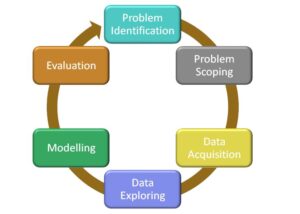AI Project Cycle : 2025 Stages, Process & Examples
Last updated on August 21st, 2025 at 03:33 pm
What is the AI Project Cycle?
Welcome to the ultimate guide on the AI project cycle! If you’re a developer, data scientist, or tech enthusiast, understanding the AI project life cycle is crucial for building successful artificial intelligence solutions. This article, updated for 2025, dives deep into the stages of AI project, the process, real-world examples, and the latest trends. Whether you’re starting with “AI development cycle” basics or aiming to master advanced techniques, TechnologyPoint.in has you covered. Let’s explore!

Introduction to AI Project Cycle
The AI project cycle is a structured process that guides the development, deployment, and maintenance of AI systems. It ensures that projects like those used by Spotify for personalized playlists or Tesla for autonomous driving are efficient and effective. In 2025, with the rise of agentic AI and multimodal models, the cycle has evolved to meet new challenges. This guide will walk you through each stage, offering insights and practical tips.
Stages of AI Project Cycle
1. Problem Scoping
What It Is: Defining the problem AI will solve, such as improving customer service or predicting equipment failure.
2025 Update: With agentic AI, scoping now includes identifying autonomous decision-making needs.
Process: Identify stakeholders, set goals (e.g., 20% accuracy improvement), and define success metrics.
Tip: Use tools like Jupyter Notebook for initial data exploration.
2. Data Acquisition
What It Is: Collecting relevant data from sources like databases, APIs, or IoT devices.
2025 Update: Data from multimodal sources (text, images, audio) is now critical, driven by models like Grok’s DeepSearch.
Process: Clean data, ensure quality, and address biases (e.g., gender imbalance in datasets).
Example: Tesla collects real-time driving data for training.
3. Data Exploration
What It Is: Analyzing data to understand patterns and anomalies.
2025 Update: Advanced visualization tools like Tableau 2025 integrate AI for real-time insights.
Process: Use statistical methods and Python libraries (e.g., Pandas, Matplotlib) to explore.
Tip: Check for missing values and outliers early.
4. Modeling
What It Is: Building and training AI models using algorithms like neural networks or decision trees.
2025 Update: Frameworks like Kubeflow and TensorFlow 3.0 dominate, supporting distributed training.
Process: Split data into training (70%), validation (15%), and test (15%) sets.
Example: Spotify uses collaborative filtering models.
5. Evaluation
What It Is: Testing the model’s performance against metrics like accuracy or F1 score.
2025 Update: New benchmarks include fairness and energy efficiency due to sustainability trends.
Process: Use cross-validation and A/B testing to refine models.
Tip: Adjust hyperparameters with GridSearchCV.
6. Deployment
What It Is: Integrating the model into production environments like apps or cloud platforms.
2025 Update: Edge AI deployment (e.g., on devices) is growing, reducing latency.
Process: Use Docker containers and CI/CD pipelines for seamless rollout.
Example: Tesla’s Autopilot updates via over-the-air deployment.
7. Monitoring and Maintenance
What It Is: Continuously tracking model performance and updating it as needed.
2025 Update: AI ops tools like MLflow 2.0 handle data drift and retraining automatically.
Process: Set alerts for performance drops and retrain with new data quarterly.
Tip: Document changes for audit trails.
AI Project Cycle Process in Detail
The AI development cycle follows an iterative approach. Start with problem scoping, then loop through data acquisition, exploration, modeling, and evaluation. Deployment marks the transition to real-world use, followed by ongoing monitoring. In 2025, agility is key—teams use DevOps practices to iterate faster, especially with real-time data from IoT and 5G.
Real-World Examples
Spotify: Uses the AI cycle to refine its recommendation engine, updating models with user listening habits.
Tesla: Employs it for Autopilot, with 2025 focusing on edge AI for better navigation.
Indian Context: Startups like Niramai use AI for breast cancer detection, following this cycle with local data.
Tools and Frameworks for 2025
Kubeflow: For managing ML workflows.
TensorFlow 3.0: Enhanced for multimodal data.
MLflow 2.0: For monitoring and versioning.
Python Libraries: Scikit-learn, PyTorch, and Hugging Face Transformers.
Benefits of Following the AI Project Cycle
Structured approach reduces errors.
Improves scalability and maintainability.
Aligns with 2025 sustainability goals (e.g., energy-efficient models).
Challenges in the AI Project Cycle
Data Quality: Incomplete or biased data can derail projects.
Data Drift: Models fail as real-world data changes (e.g., post-2025 economic shifts).
Cost: High computational needs, especially with large datasets.
2025 Outlook
The AI project process is evolving with agentic AI, where systems self-adapt, and multimodal learning, combining text, images, and audio. Expect more focus on ethics, privacy (e.g., GDPR compliance), and green AI. TechnologyPoint.in will keep you updated!
Conclusion
Mastering the AI project cycle is essential for success in 2025’s AI landscape. From problem scoping to monitoring, each stage builds a robust solution. Explore more at TechnologyPoint.in, and download our 2025 AI Project Cycle Guide to get started!